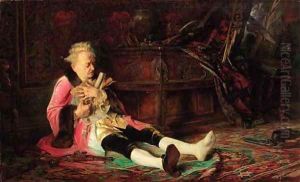Iosif (Osip) Karlovich Paintings
Iosif (Osip) Karlovich, also known as Osip Zadkine, was a Russian-born artist who played a significant role in the development of modern sculpture. Born on July 14, 1888, in Vitebsk, then part of the Russian Empire (now in Belarus), Zadkine was part of a Jewish family, which influenced much of his early life and later works. His artistic journey began in his homeland, but his quest for artistic growth led him to move to London in 1905, where he studied at the Central School of Arts and Crafts. Seeking a more vibrant artistic community, he relocated to Paris in 1909, which was then the epicenter of the avant-garde.
In Paris, Zadkine became an integral part of the artistic community, mingling with other influential artists of the time, including Picasso, Modigliani, and Brancusi, which significantly influenced his work. His early pieces were primarily in wood and stone, but over time, he began to experiment with more abstract forms, incorporating elements of Cubism and Futurism. Zadkine's sculptures from this period are characterized by their fragmented forms and innovative use of space, reflecting the tumultuous era's impact on the artist.
Throughout his career, Zadkine explored themes of human suffering, love, and the resilience of the human spirit. One of his most famous works, 'The Destroyed City' (1953), created as a memorial to the city of Rotterdam, which was heavily bombed during World War II, showcases his ability to convey powerful emotions through abstract forms. This monumental sculpture is a testament to Zadkine's mastery of expressing the human condition's complexity through his art.
Zadkine's contributions to modern sculpture were not limited to his innovative techniques and thematic explorations. He was also a respected teacher, sharing his knowledge and passion for art with students at the Académie de la Grande Chaumière in Paris. His influence extended beyond his lifetime, inspiring future generations of artists to explore the expressive potential of sculpture.
Zadkine's work has been exhibited in major museums and galleries worldwide, and his legacy as a pioneering figure in modern sculpture continues to be celebrated. He passed away on November 25, 1953, in Paris, but his art remains a powerful reminder of the transformative power of creativity and the enduring human spirit.
